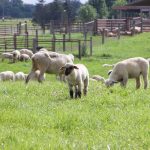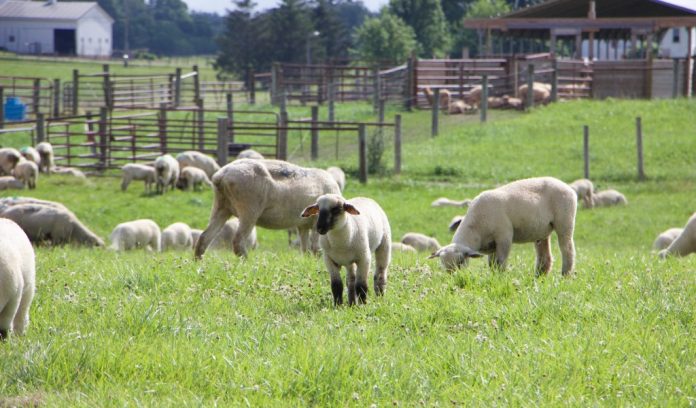
(Scroll down for photo gallery)
WOOSTER, Ohio — Ohio is the largest sheep-producing state east of the Mississippi, said Dave Benfield, associate vice president for agricultural administration and director of Ohio State’s wooster campus. For that, he said, Ohio sheep producers should be proud of the work they have invested into improving their flocks.
The Ohio Agricultural Research and Development Center (OARDC) sheep research facility hosted the Ohio Sheep Day, July 15. Sheep producers came to learn about Ohio State’s research on parasites and pasture management, new weaning techniques for lambs, confinement setups and protecting their flocks from predators.

Confinement barns
While many producers prefer to have a pasture-based system for their lamb operations, pastures pose two threats — parasites and predators. Ohio State animal scientist Dr. Francis Fluharty walked producers through different confinement options.
One of the biggest aspects to consider is air flow. He suggested constructing a monoslope barn similar to what many cattle operations use. The benefits of these barns is the air flow minimizes the ammonia smell and cuts down on flies accumulating in pens.
The air flow and the sunlight that pass through a monoslope barn help air out the manure pack in the winter and dry the pack in the summer.
Sheep perspective
Fluharty explained the only way to truly get a sense of the airflow the animal is experiencing, is to get down on the their level — which he demonstrated by getting down on all fours.
“We have to think like a sheep… think about how high the animals actually are from the ground,” he said.
Curtains can be installed to offset the cold and heat, but opening them from the bottom instead of the top, can make a difference in the air flow to the animal.
The down side to confinement setups is the cost of feed necessary to supplement the sheep not on pasture and the extra labor in barn upkeep.
Fluharty said it’s important, even in a confinement setup, that sheep get their exercise. Having a hard, dry area outside the barn where the sheep can run a few hours a day is essential. “A ewe has to be an athlete,” otherwise they become couch potatoes, he said.
Ohio State confinement barn
Pasture based lambing operation face two main challenges — parasites and predators. Confinement barns, like this one, give sheep producers another option for raising sheep.
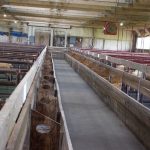 View
View
Ohio State confinement barn
Pasture based lambing operation face two main challenges — parasites and predators. Confinement barns, like this one, give sheep producers another option for raising sheep.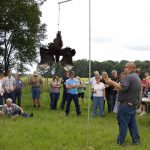 View
View
Vulture attacks
Tommy Butler, a certified wildlife biologist with USDA Wildlife Services, shows how producers can protect their flocks from black vultures. View
View
Ohio State sheep research
Brady Campbell and Jeff McCutcheon talk about research on sheep weaning and parasite management during Ohio Sheep Day, July 15.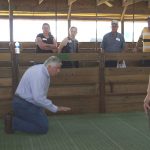 View
View
Think like a sheep
Dr. Francis Fluharty explained the only way to truly get a sense of the airflow the animal is experiencing, is to get down on the their level — which he demonstrated by getting down on all fours.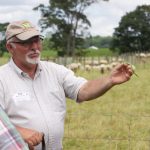 View
View
Pasture management
Bob Hendershot, vice-chair of Green Pasture Services and Ohio Sheep Improvement Association board member, talks with sheep producers about forage quality and pasture management during a pasture walk of the OARDC sheep research facility in Wooster, July 15, part of Ohio Sheep Day.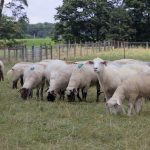 View
View
sheep day 7
The Ohio Agricultural Research and Development Center’s sheep research facility is home to close to 300 ewes. The ongoing research and new trends in sheep production was highlighted at Ohio Sheep Day July 15. Producers learned about parasite and pasture management, weaning techniques and protection from predators.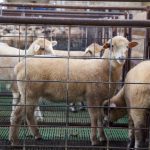 View
View
Sheep
Producers got a closer look at different management techniques for sheep, during Ohio Sheep Day at the OARDC sheep research facility.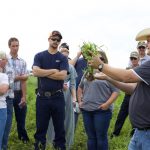 View
View
Parasite management
Jeff McCutcheon, Ohio State Extension regional director and Ohio Sheep and Wool Producers board member, explained to sheep producers the life cycle of parasites and how they affect sheep, during a pasture walk at the OARDC sheep research facility, in Wooster, Ohio, July 15. View
View
Hoof trimming
Roger Shearer showed sheep producers how he trims hoofs and cares for the sheep at the OARDC sheep research facility in Wooster, Ohio, during Ohio Sheep Day July 15.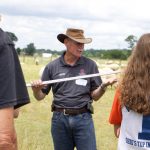 View
View
Pasture management
Rory Lewandowski shows sheep producers how to measure the amount of forage available in their fields.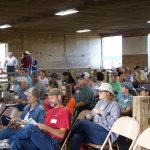 View
View
Full barn
It was a full barn during Ohio Sheep Day at the OARDC sheep research facility July 15.Weaning
Ohio State graduate student Brady Campbell walked producers through his research project on traditional lamb weaning versus delayed weaning. For his study, Campbell compared weaning at the traditional 60 days compared to leaving the lamb with its mother for 120 days.
The study revealed that lambs left with their mothers longer gained more weight than those separated after 60 days. Campbell explained a few reasonings behind this.
When a lamb is separated from its mother, it undergoes stress. Lambs also learn how to eat from their mother.
The milk from the ewe is higher in energy and protein than traditional feed sources. So leaving the animals together longer could potentially save on feed costs and be a better nutritional supplement for the lambs.
Pasture walk

Bob Hendershot, vice chair of Green Pasture Services and Ohio Sheep Improvement Association board member, and Rory Lewandowski, OSU Extension educator in Wayne County, led producers on a pasture walk.
“You should be making decisions about pasture management, not your ewes,” said Hendershot. It’s important to think long-term when raising pasture-based animals, in order to keep forage quality up and make sure there is enough in the fields to last your grazing season.
Using a simple pasture stick, Lewandowski showed producers how to measure pasture length and the amount of dry matter available in your field. During their walk, Hendershot and Lewandowski described the best forages to incorporate in fields and what to avoid.
Roger High, executive director Ohio Sheep Improvement Association and Ohio Sheep and Wool Producers, and OSU state sheep Extension specialist, said he hoped producers found something they could take back from Ohio Sheep Day to improve their own flocks and operations.
You can find more on Ohio sheep events and programs at ohiosheep.org.







